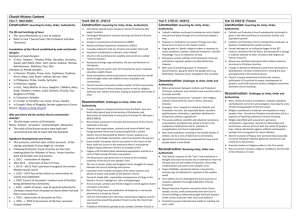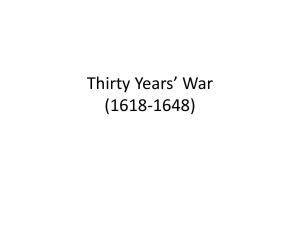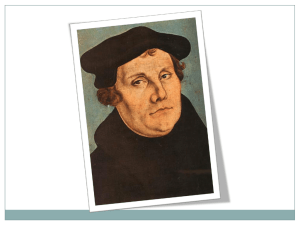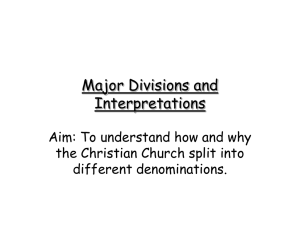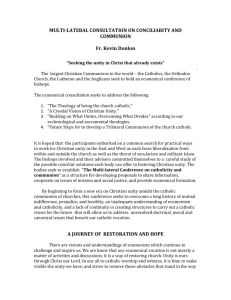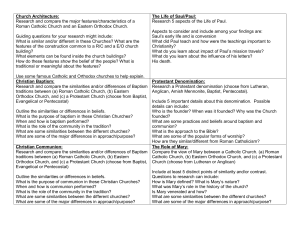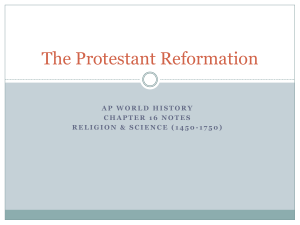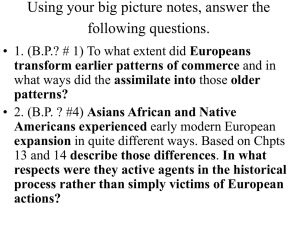Church History Timeline: 6 BCE to Present
advertisement
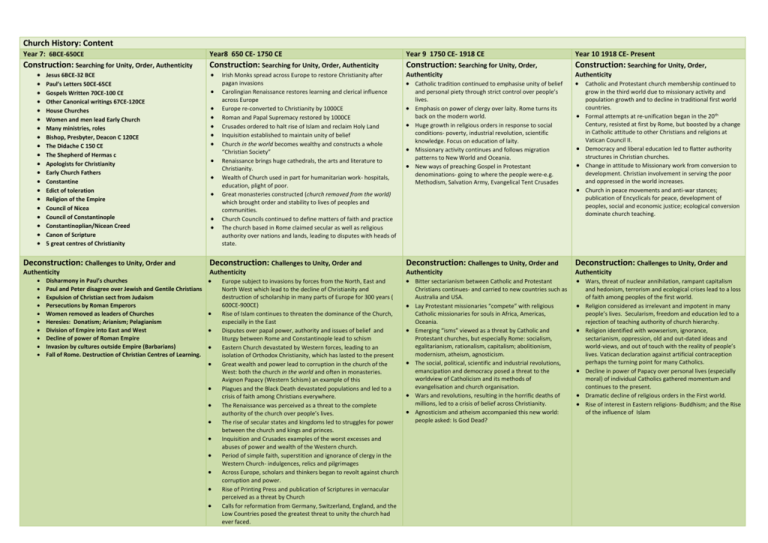
Church History: Content Year 7: 6BCE-650CE Year8 650 CE- 1750 CE Year 9 1750 CE- 1918 CE Year 10 1918 CE- Present Construction: Searching for Unity, Order, Authenticity Construction: Searching for Unity, Order, Authenticity Construction: Searching for Unity, Order, Construction: Searching for Unity, Order, Authenticity Catholic tradition continued to emphasise unity of belief Authenticity Catholic and Protestant church membership continued to Jesus 6BCE-32 BCE Paul’s Letters 50CE-65CE Gospels Written 70CE-100 CE Other Canonical writings 67CE-120CE House Churches Women and men lead Early Church Many ministries, roles Bishop, Presbyter, Deacon C 120CE The Didache C 150 CE The Shepherd of Hermas c Apologists for Christianity Early Church Fathers Constantine Edict of toleration Religion of the Empire Council of Nicea Council of Constantinople Constantinoplian/Nicean Creed Canon of Scripture 5 great centres of Christianity Irish Monks spread across Europe to restore Christianity after pagan invasions Carolingian Renaissance restores learning and clerical influence across Europe Europe re-converted to Christianity by 1000CE Roman and Papal Supremacy restored by 1000CE Crusades ordered to halt rise of Islam and reclaim Holy Land Inquisition established to maintain unity of belief Church in the world becomes wealthy and constructs a whole “Christian Society” Renaissance brings huge cathedrals, the arts and literature to Christianity. Wealth of Church used in part for humanitarian work- hospitals, education, plight of poor. Great monasteries constructed (church removed from the world) which brought order and stability to lives of peoples and communities. Church Councils continued to define matters of faith and practice The church based in Rome claimed secular as well as religious authority over nations and lands, leading to disputes with heads of state. and personal piety through strict control over people’s lives. Emphasis on power of clergy over laity. Rome turns its back on the modern world. Huge growth in religious orders in response to social conditions- poverty, industrial revolution, scientific knowledge. Focus on education of laity. Missionary activity continues and follows migration patterns to New World and Oceania. New ways of preaching Gospel in Protestant denominations- going to where the people were-e.g. Methodism, Salvation Army, Evangelical Tent Crusades grow in the third world due to missionary activity and population growth and to decline in traditional first world countries. Formal attempts at re-unification began in the 20th Century, resisted at first by Rome, but boosted by a change in Catholic attitude to other Christians and religions at Vatican Council II. Democracy and liberal education led to flatter authority structures in Christian churches. Change in attitude to Missionary work from conversion to development. Christian involvement in serving the poor and oppressed in the world increases. Church in peace movements and anti-war stances; publication of Encyclicals for peace, development of peoples, social and economic justice; ecological conversion dominate church teaching. Deconstruction: Challenges to Unity, Order and Deconstruction: Challenges to Unity, Order and Deconstruction: Challenges to Unity, Order and Deconstruction: Challenges to Unity, Order and Authenticity Authenticity Europe subject to invasions by forces from the North, East and Authenticity Bitter sectarianism between Catholic and Protestant Authenticity Wars, threat of nuclear annihilation, rampant capitalism Disharmony in Paul’s churches Paul and Peter disagree over Jewish and Gentile Christians Expulsion of Christian sect from Judaism Persecutions by Roman Emperors Women removed as leaders of Churches Heresies: Donatism; Arianism; Pelagianism Division of Empire into East and West Decline of power of Roman Empire Invasion by cultures outside Empire (Barbarians) Fall of Rome. Destruction of Christian Centres of Learning. North West which lead to the decline of Christianity and destruction of scholarship in many parts of Europe for 300 years ( 600CE-900CE) Rise of Islam continues to threaten the dominance of the Church, especially in the East Disputes over papal power, authority and issues of belief and liturgy between Rome and Constantinople lead to schism Eastern Church devastated by Western forces, leading to an isolation of Orthodox Christianity, which has lasted to the present Great wealth and power lead to corruption in the church of the West: both the church in the world and often in monasteries. Avignon Papacy (Western Schism) an example of this Plagues and the Black Death devastated populations and led to a crisis of faith among Christians everywhere. The Renaissance was perceived as a threat to the complete authority of the church over people’s lives. The rise of secular states and kingdoms led to struggles for power between the church and kings and princes. Inquisition and Crusades examples of the worst excesses and abuses of power and wealth of the Western church. Period of simple faith, superstition and ignorance of clergy in the Western Church- indulgences, relics and pilgrimages Across Europe, scholars and thinkers began to revolt against church corruption and power. Rise of Printing Press and publication of Scriptures in vernacular perceived as a threat by Church Calls for reformation from Germany, Switzerland, England, and the Low Countries posed the greatest threat to unity the church had ever faced. Christians continues- and carried to new countries such as Australia and USA. Lay Protestant missionaries “compete” with religious Catholic missionaries for souls in Africa, Americas, Oceania. Emerging “isms” viewed as a threat by Catholic and Protestant churches, but especially Rome: socialism, egalitarianism, rationalism, capitalism; abolitionism, modernism, atheism, agnosticism. The social, political, scientific and industrial revolutions, emancipation and democracy posed a threat to the worldview of Catholicism and its methods of evangelisation and church organisation. Wars and revolutions, resulting in the horrific deaths of millions, led to a crisis of belief across Christianity. Agnosticism and atheism accompanied this new world: people asked: Is God Dead? and hedonism, terrorism and ecological crises lead to a loss of faith among peoples of the first world. Religion considered as irrelevant and impotent in many people’s lives. Secularism, freedom and education led to a rejection of teaching authority of church hierarchy. Religion identified with wowserism, ignorance, sectarianism, oppression, old and out-dated ideas and world-views, and out of touch with the reality of people’s lives. Vatican declaration against artificial contraception perhaps the turning point for many Catholics. Decline in power of Papacy over personal lives (especially moral) of individual Catholics gathered momentum and continues to the present. Dramatic decline of religious orders in the First world. Rise of interest in Eastern religions- Buddhism; and the Rise of the influence of Islam Protestant Christianity spreads across Europe: Christian Church in the West divided between Churches loyal to Rome and multiple denominations claiming a return to Bible-based authority. Some national churches such as Church in England. A period of bitter attack and counter-attack between churches and countries loyal to Rome and Protestant countries and groups. (1548 CE-1750 CE) Wars of words and weapons break out across Europe in the name of Christianity. Ordinary people suffer from the excesses of both sides. Christianity bitterly divided for centuries to come. Reconstruction: Restoring Unity, Order and Authenticity Reconstruction: Restoring Unity, Order and Authenticity Council of Jerusalem Order and uniformity to church structures: Bishop, deacon, presbyter Apologists for Christianity- Early Church Fathers Collation of written texts Edict of Toleration Church Councils respond to differences Common creed, canon of Scripture, authority structures Rise of Roman Pontiff as Supreme Head of Church Church structures take over civil authority in a declining Empire. Church structures and roles take on model of Roman Empire Church in Eastern Empire continues to flourish (Constantinople) until 1000CE Christian learning preserved in Irish monasteries and returned to Europe via missionary monks. Reforms of Charles, Holy Roman Emperor, led to re-establishment of the church in Europe and conversion of invaders. Great thinkers and reformers arose in the church to counter corruption and ignorance in the secular and monastic church Western church response to dissent and challenge was often brutal and scandalous: Inquisition torture; Interdicts placed on whole nations and peoples. Rome’s response to the Reformation was to excommunicate reformers and to condemn calls for reform. The Council of Trent, while a turning inward of Church of Rome, did institute significant reform of clergy, liturgy and spirituality. Counter-Reformation in Roman Catholic tradition- internal reform and attempts to regain countries and peoples lost to protestant Christianity. Jesuits lead the catholic thrust to regain lost congregations Catholic church, in response to the Reformation reforms its structures in parishes and focuses on personal piety and spirituality, and absolute unity. A catechism of beliefs produced. Education of laity in faith. Both Catholic and Protestant Christianity seek membership by conversion through missionary activity in Asia, Africa, the Pacific and the Americas. Reconstruction: Restoring Unity, Order and Reconstruction: Restoring Unity, Order and Authenticity The Catholic response to the “isms” and revolutions in Authenticity Second Vatican Council brought revolutionary change to thought and social structures was an attempt to return to the past and use old models of expulsion, censorship, condemnation and control over people’s lives. Papal Infallibility, decreed at Vatican I, became the ultimate sign of Catholicism’s rejection of the modern world The Catholic church challenged the worst excesses of rampant capitalism thorough publication of Social Encyclicals. Many Protestant churches returned to Early Church models: lay-led, small communities that went out of church buildings to where the people lived and worked: street corners and town halls, tents and stadiums. Protestant groups embraced new media in reaching outprint, radio. Christian reformers joined great social reform movements for the abolition of slavery, child labour and exploitation of workers and the emancipation of women and working classes. Catholic Church, where church changed from rejecting the modern world to embracing and evangelising it. Protestant Christians embrace media and technology to bring religion to the masses: televangelism; internet; advertising. Ecumenical movement sought to focus on what Christians have in common, not what divides them. Christians sought to work together in Missionary Development work, education and social reform. Role of Laity in Catholic Church leads to greater involvement and a renewed membership. Catholic schools the main tool for evangelisation and support of faith in countries such as Australia and Third World. Migration of peoples brought change to the cultural expression and observance of Christianity for Catholic and Protestant churches. Christianity came to terms with being one faith in a multicultural, multi-faith world and no longer the only influence on secular governments.
